Chapter 2: Being a Customer Service Representative (CSR)
Chapter 2 Learning Outcomes
After reading this chapter, you should be able to do the following:
- Describe the role of the customer service representative.
- Identify skills required by customer service representatives.
- List the benefits of providing excellent customer service.
- Use positive language that will enhance customer relationships.
- Use a variety of non-verbal communication strategies.
- Describe why active listening is important to customer service.
- Practice daily rituals to maintain a positive attitude.
- Apply time management techniques.
- Apply stress management techniques.
“Customer service is both a type of job and a set of job skills. As a job, customer service professionals are responsible for addressing customer needs and ensuring they have a good experience. As a skill set, customer service entails several qualities like active listening, empathy, problem-solving, and communication. Customer service is used in many jobs at every level. While traditionally you might think of customer care as a service from a business to a consumer (B-2-C), it is also applicable from one business to another business (B-2-B) and from one business to another department within the same business. For example, you may be in a role that provides services to other, internal teams. In this case, you would want to ensure that you understood and were able to meet their needs.”[1]
When you think of the people that work in a customer service role, who do you think of? Do you think of the person that greets you at the restaurant, the person who answers the phone when you call your phone service provider for support or the person who delivers the products you ordered online to your home? Each of these people is certainly working in a customer service role. What you might be surprised to know is that every job position has some degree of customer service embedded in the role. People who work in the information technology, human resources, or finance departments do not usually interface with external customers on a day-to-day basis, but they do interact with their colleagues regularly. Internal customers are the company employees who need support, information, or action from other employees. These internal customers may work just down the hall, in another building, or in another country, but they are still part of the company and are working to help satisfy external customers. External customers are the customers who purchase products or services from the company. Employees who work in job positions that require them to interface with external customers directly might be referred to as front-line, front-facing, front-end, or customer-facing employees. Those that work to serve internal customers are working in back-end/back-office/behind-the-scene job positions.
An example of an employee working to serve an external customer may be a situation where a customer phones the store’s service desk and the employee who answers the phone listens attentively to the customer’s story, then places the customer on a brief hold while they check with the manager or another employee about the customer’s concern or query. The employee who is asking for help has become an internal customer at that moment in time, as they are receiving support from their manager or co-worker. After they receive support, they then return to the phone to follow up with the external customer and finish the call. It takes a team working together to provide excellent customer service. Those external customers who purchase the products and services the company provides are the ones keeping the company alive, and ensuring employees have jobs. If there were no customers there would be no need for employees!
As a service professional, you are the “face” of your organization in customer interactions. Your primary function is to listen actively and gather the information needed in order to make a decision on what course of action is needed to best serve the customer in any given situation. This typically requires a polite, professional demeanor and effective and efficient answers to questions or resolutions to problems.[2]
Capabilities Customer Service Professionals Require
How can employers ensure they are hiring the right people to represent their brand or uphold their company image? What skills can customer service professionals develop to become more proficient at their jobs? There are many skills customer service professionals need to be excellent in their jobs, these include the ability to communicate clearly, use positive language, use positive body language, serve diverse customers, be persuasive, use active listening, interact positively in a team, learn continuously, manage time, and manage stress. They also need to be able to show empathy and think critically to solve problems creatively. These skills and more are critical to creating outstanding customer experiences, and most require a lot of time and practice to truly master.
Some of the capabilities customer service professionals must have, include the following:
- Service Orientation
- Interpersonal communication
- Positive, customer-focused, “can-do” attitude
- Problem-solving, creativity, conflict resolution
- Manage information
- Responsible and professional behaviour
- Learn continuously (have a broad knowledge of company products and services)
- Time management
- Stress management
- Team spirit and participation
Each of the customer service skills that are necessary for success in this key role is detailed below.
Ability to Demonstrate a Customer Service Orientation
You might notice in some job advertisements the phrase, “must have a Customer Service Orientation”. Customer Service Orientation means that as an employee you are able to display positive attitudes and behaviours, and demonstrate an awareness of the importance of meeting or exceeding customer needs and expectations. Many businesses today think more about attracting new leads, maximizing sales, upselling, expanding market share, and obtaining a bigger “share of wallet”, than they do about meeting and exceeding customer needs. While increasing profit is important, a company with a genuine customer-first approach will care about customers and their needs because they understand that this is how they can grow profit.
In practice, it might mean that the company trains its service representatives not to upsell products or services to customers that do not need them or want them. It may mean that service representatives do not encourage customers to upgrade a subscription if the customer will not benefit from upgrading. Sometimes, it even means letting a customer go or referring them to a competitor if the solutions your company offers are not best suited for the customer. Have you ever shopped at a company and discovered they did not sell what you needed or wanted? Did a service representative suggest you visit a competing company for that particular product or service? Why do you think they referred you to a competitor rather than trying to sell you something else, or just saying, “We don’t carry that item”? There may be some good reasons for referring customers to competitors, such as creating a positive company image, spreading positive word-of-mouth, connecting with other businesses in a joint effort that will benefit both companies, supporting the values the company has around true customer centricity, building trust and loyalty with customers, and highlighting your company’s confidence in the products and services you do sell. A great example of this comes from Zappos, “Zappos ‘refer to competitor’ tactic (when they don’t have an item in stock)–reflects an incredibly strong customer-centric DNA. The primary focus is not only to maximize revenues but to get the customer exactly what they’re looking for. “[3] It’s also ‘un-corporation like’ to center on the customer to such a degree that you try to sell them something similar that is in stock that they don’t really want, instead of referring them to a competitor to get the exact product they want.
Service culture in an organization means putting customers at the center of the business model, developing policies, procedures, values, norms, and beliefs that are centered around focusing on customer satisfaction and understanding their needs and wants.
Company policies, procedures, and employees’ actions contribute to the organization’s service culture. Employees communicate the company culture through their appearance, interactions with customers, product knowledge, skills, and attitude. Maintaining a friendly, positive, and professional attitude in the workplace will take you far. Here are a few of the benefits of providing excellent customer service, for the employee, the company, and the customer.
Employee Benefits from Providing Excellent Customer Service
- Receive promotions, bonuses, recognition
- Receive project opportunities, growth opportunities
- Retain employment
- Intrinsic rewards from knowing you did the best job you could
- Better relationships with customers
- Better relationships with colleagues
- Better relationships with management
- Happier life
Company Benefits from Providing Excellent Customer Service
- Positive reviews from customers
- Increased revenues, customers spend more, give referrals
- Positive word-of-mouth, positive company image
- Retain employees longer
- Company growth
- Customers involved in company projects
- Increased customer lifetime value (CLV)
- Retaining customers longer thereby reducing costs in recruiting new customers
Customer Benefits from Receiving Excellent Customer Service
- Obtain objectives and have issues resolved
- Get involved in company projects
- Rewards for continued loyalty
- Build relationships with employees
- Take advantage of company opportunities
- Happier life
Ability to Apply Fundamental Work Skills
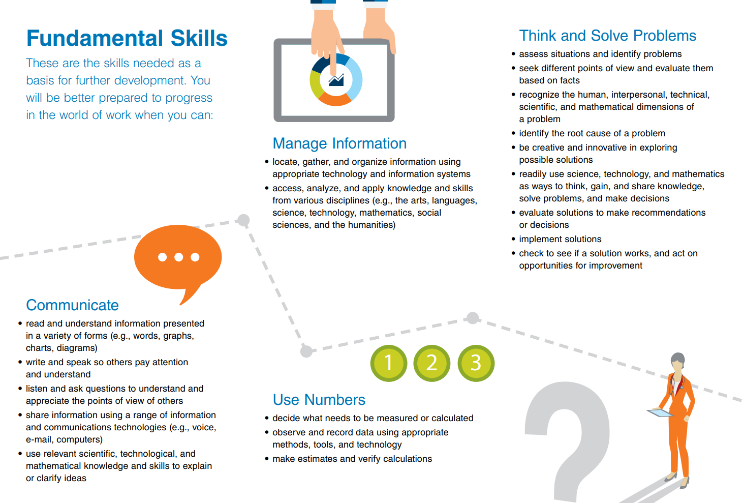
Ability to Communicate Verbally and Non-Verbally
It is important that a service professional fully understands the customer’s needs and is careful to clearly provide answers, directions, facts, or any other information required to make the sale or serve the customer and build a positive customer relationship. When communication is unclear, customers may misunderstand or misinterpret the message and this could lead to lost business. For example, a customer may ask, “Are there any fries?” when they really mean, “Are fries included with the meal at no extra charge.” The service provider may answer, “Yes” only to discover that the customer is upset when the bill arrives to see that they were charged extra for the fries they thought were included in the price. A service provider may need to ask a customer some questions to clarify the customer’s expectations and needs before the food order is placed to ensure nothing is left to doubt.
In its Employability Skills 2000+, the Conference Board of Canada lists “the skills you need to enter, stay in, and progress” in the 21st-century workplace. The ability to apply fundamental work skills is one of the skills listed.[4]
Specifically, communication skills:

- read and understand information presented in a variety of forms (e.g., words, graphs, charts, diagrams)
- write and speak so others pay attention and understand
- listen and ask questions to understand and appreciate the points of view of others
- share information using a range of information and communications technologies (e.g., voice, e-mail, computers)
- use relevant scientific, technological, and mathematical knowledge and skills to explain or clarify ideas
Face-to-face communication is the richest form of communication because it allows for the simultaneous interpersonal exchange of cues from linguistic content, tone of voice, facial expressions, direction of gaze, gestures, and postures.[5] Verbal communication coexists alongside non-verbal communication, which can affect people’s perceptions and exchanges in subtle but significant ways.
Verbal communication refers to the ability of a customer service representative to think of the right words in order to appease a customer and provide a solution. It does not necessarily mean that a service representative should sound too formal and robotic while communicating with customers. Though being too informal is not good either as it could leave the customer with a negative impression. Keeping a balance is what a customer representative should strive for.
10 Tips for Effective Communication with Customers[6]
- Patience is a must
- Accuracy of information is key
- Proactive approach always delights customers
- Attentiveness helps
- Avoid interrupting
- Know your product/service offered inside out
- Honesty works every time
- Active Listening and acknowledgments do wonders
- Analogies help in getting your message across
- Don’t take shortcuts
Non-verbal communication refers to gestures, facial expressions, eye contact, body language, posture, and other ways people can communicate without using language. Your nonverbal communication skills can create a positive (or a negative) impression. Crossed arms can seem defensive. Poor posture may appear unprofessional. A downward gaze or avoiding eye contact can detract from your being seen as confident.
During cross-cultural communication, one should follow one general suggestion: write or speak simply and clearly. Avoid slang, vague words, or colloquialisms. Listen carefully with a positive approach. Speak slowly and be specific. The more you learn about various cultures the better communicator you will become. It is suggested to avoid non-verbal hints because they have different meanings in different cultures; for example, some hand gestures have different meanings among different cultures, so be cautious when using them.
Watch the “Positive Body Language” YouTube video below for tips on positive body language as it pertains to Canadian culture.[7] Transcript for “Positive Body Language” Video [PDF–New Tab]. Closed captioning is available on YouTube.
Ability to Use Positive Language
Positive language is the art of using words and phrases to communicate a positive, supportive tone to your customers (or anyone else for that matter). Using positive language is important for building rapport with others. Sharing bad news with customers is a part of being a customer service professional. Customer service professionals must learn how to share negative information without being negative. When sharing negative information that may make a customer upset, sad, or angry it is always best to speak face-to-face, but that may not always be possible, and sometimes negative messages must be sent through email or postal mail.
Watch the “Service Recovery – Do Say / Don’t Say” YouTube video below to learn key words and phrases to de-escalate tense situations.[8] Transcript for “Service Recovery – Do say/Don’t say” Video [PDF–New Tab]. Closed captioning is available on YouTube.
Language is a crucial part of how we interact with others and the perceptions they form of us. For example, a customer may contact the company seeking a specific product, but the product happens to be on back-order until next month. The way the customer service professional uses words to convey that the product is on back-order will help to make or break the sale. Without using positive language, the sales might say, “Sorry, the product is on back-order and won’t be available until next month.” With positive language, the sales representative might say, “The product will be available next month, and I’m happy to place the order now for you and have it shipped directly to you as soon as it arrives.” Do you see the difference using positive language makes? The first example seems abrupt and impersonal and may upset customers, while the second example is saying the same thing but it focuses on when and how the issue will be resolved rather than focusing on the negative.
Watch the “Sharing Negative Information without Being Negative” YouTube video below to learn how to share negative information with others.[9] Transcript for “Sharing Negative Information without Being Negative” Video [PDF–New Tab]. Closed captioning is available on YouTube.
Ability to Listen Actively
Active listening means that you focus on what your customer is saying. You try not to let your mind wander while your customer is speaking. You paraphrase what the customer has said and ask the customer if your understanding of what they have told you is correct. You may ask customers questions to obtain more details of what the issue is. You may have to calm an upset customer. Certainly, the customer is there to gather answers and see results so put yourself in the customer’s shoes, and really listen to their story so you can provide the best customer service you can.
Watch the “Customer Service Fundamentals – Actively listening to Customers” YouTube video below to learn about active listening.[10] Transcript for “Customer Service Fundamentals – Actively Listening to Customers” Video [PDF–New Tab]. Closed captioning is available on YouTube.
Ability to Think and Solve Problems
Service breakdowns occur daily in all types of organizations. They happen whenever the product or service delivered fails to meet customer needs, wants, and expectations. When the customer purchases a product or service that fails to meet the advertised promises or standards, dissatisfaction and frustration can result which may lead to confrontation and/or loss of business.
“Customer expectations can affect how service is delivered and perceived. Today’s customers are more discerning and better educated, have access to more up-to-date and accurate information. They also have many more options offered by your competitors. They are often more demanding than in the past. Their expectations about your products and services and the way that you will provide them may create a situation where little you do or say can meet their perceptions. In such cases, remain professional, positive and offer alternatives or concessions, if appropriate, in order to maintain the relationship and provide what the customer needs or wants.”[11]
The training video below was posted on YouTube by Kantola Training Solutions and includes valuable tactics for dealing with angry, upset, difficult, or irate customers, and includes the following topics:
- Connect with the angry customer.
- Show empathy or apologize if appropriate.
- Guide the customer’s attention toward solving the problem.
- Use positive language.
- Have the customer make small decisions.
- Take a timeout or draw the line.
- Know what you can offer.
Watch the “Dealing with an Angry Customer Training” YouTube video below to learn more about dealing with angry customers.[12] Transcript for “Dealing with an Angry Customer Training” Video [PDF–New Tab]. Closed captioning is available on YouTube.
When dealing with angry customers it is important to use positive language, for example, let them know what you can do for them rather than what you cannot do for them to resolve their issue. Avoid saying, “We don’t.” If you are unable to offer something or provide a service the customer wants, then you might say, “What I can do for you is offer you is…” or “I’m sorry, we don’t actually sell that product, although we do sell something similar if you are interested,” or “I’ sorry, we do not sell that product, but you might try Best Buy,” or “I’m sorry, we do not have that item in stock, would you like me to check our other store locations for you,” instead of saying, “We don’t have that,” or “We don’t do that.” Avoid saying, “I cannot,” “Our policy does not allow for that,” or “No.” Instead try saying, “I understand why you may be upset. I might be upset too in this situation. You have had the cell phone longer than the 30-day exchange window, so what I can do for you in this situation is…” or “I understand what you are asking for, and my manager will need to consider this request. Would you mind waiting a minute while I get my manager?”
Service recovery is a company’s resolution of a problem from a dissatisfied customer, converting them into a loyal customer. It is the action a service provider takes in response to service failure. It entails the company taking appropriate actions in response to a service failure. The service failure may have occurred for all sorts of reasons–the service may be unavailable when promised, it may be delivered too late or too slowly, the outcome may be incorrect or poorly executed, or employees may be rude or uncaring. If you are the customer service representative serving a customer experiencing a service failure, you represent the company, therefore you need to apologize, solve the problem, and compensate the customer with something of value. Managers need to create a service recovery process and train employees on the process. Starbucks and other fast-paced businesses make a point of training via acronyms and other mnemonics because these can help employees mentally walk through the steps at times when they may be flustered and struggling with a situation. Starbucks uses the acronym LATTE for the customer service recovery sequence where L=Listen to the customer, A=Acknowledge the problem/situation by verbally explaining it, T=Take action and solve the problem (this is an opportunity to turn a bad experience into a good one), T=Thank the customer for bringing this to your attention, E=Explain what you did and encourage the customer to return another time. The service recovery sequence at Marriott Hotels spells LEARN where L=Listen, E=Empathize, A=Apologize, R=Respond, and N=Notify.[13]
Another great way to solve customer problems is to apply a problem-solving model. A problem-solving model provides you with concrete, easy to remember steps you can work through when faced with any issue, customer service related or other. Your company may have its own version of how to approach customer problems, but here is a simple breakdown used by many customer service teams around the world in some similar variation.
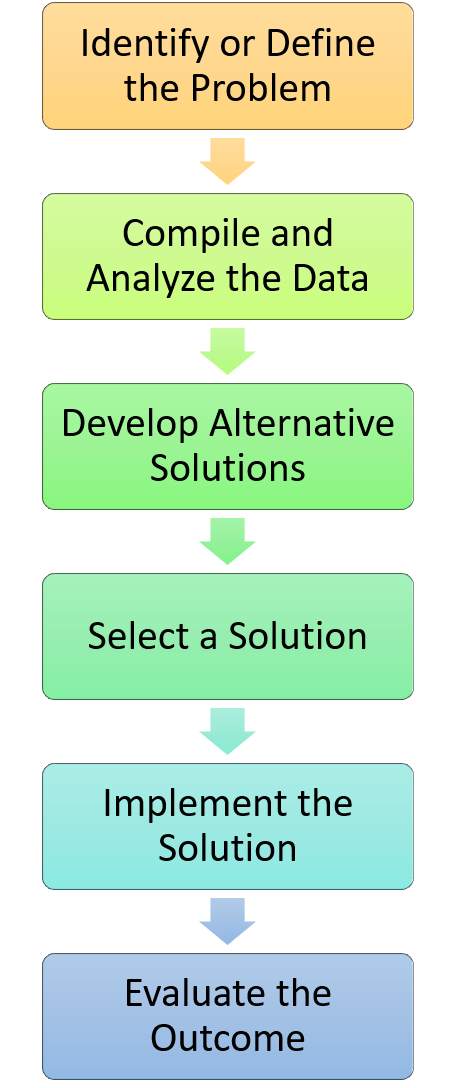
- Identify or Define the Real Problem. What exactly is the problem? You may need to ask the customer some open-ended questions to gather more information or do some research to look into some facts, then determine with the customer what the exact problem is. You want to be solving the customer’s problem and not assuming you know what they are upset about.
- Compile and Analyze the Data. To be able to effectively determine a course of action you need as much information as possible. You may need to collect information from a variety of sources. Collate the information in a structured way, and focus in on the underlying causes of the problem.
- Develop Alternative Solutions. Analytical, creative problem solving is about creating a variety of solutions, not just one. At this stage, it is not about finding one solution but eliminating the options that will prove less effective at dealing with both the symptoms and the root cause.
- Select a Solution. You need to examine which alternative solutions best solve the problem as well as which solutions are doable. If your company, for example, is not able to provide the solution you selected, then you would not want to offer it to the customer. You might offer a choice of solutions to the customer, those that are feasible, and let your customer select the one they prefer. If the solution is too unrealistic, too expensive, too time consuming, or too risky for your company, then you need to go back a step and consider additional alternatives. As well, if the solution is not satisfying the customer or solving the problem, you need to backup and consider alternative solutions; you may even need to bring your manager into the conversation.
- Implement the Solution. Take action. You may need to communicate with other team members or your manager to put the solution into action, or you may simply need to apologize to the customer, thank them for bringing this issue to your attention, and/or refund the customer. If the problem was more complex you may have to reorder an item and provide the customer with a receipt and expected delivery date. Following up with the customer is a best practice in these more complex cases.
- Evaluate the Outcome. Follow up with the customer and/or your team to ensure the solution was implemented and the customer is satisfied. You may need to take action to correct something if things did not go as planned and it is better to catch this before you lose the customer completely. You might even ask the customer to provide feedback, evaluate the service, or complete a survey. You might need to adjust the customer service process if the process was an issue, and this may include sharing the experience with your manager, especially if the process is broken and causes several customers to become dissatisfied. You can suggest improvements to your manager and avoid repeat customer service breakdowns. Your manager will be happy you did.
Ability to Manage Information
Email is a business tool used around the world in millions of businesses. It is fast, inexpensive and can send a message to almost any place in the world. As a customer service representative, you will use email to correspond with managers, colleagues, customers, and partners. It is important to follow company guidelines when sending any correspondence. Often companies have guidelines for font size, type, letterhead, signature blocks, etc. It is equally important to use professional language, steer clear of text chat short-cuts you may use with your friends, and ensure a polite and caring tone; after all, you are representing the company.
The Indeed Career Guide offers 20 Best Practices for Email Etiquette in the Workplace [14]and includes these tips:
- Use standard fonts and formatting
- Include a clear subject line
- Email from a professional email address
- Use professional greetings
- Use an introduction
- Know the culture
- Be cautious with “Reply All”
- Use sentence case
- Double-check attachments
- Proofread
- Don’t use emojis
- Be positive
- Reply within 24 hours
- Keep your tone professional
- Check the recipient’s name
- Shorten URLs
- Perfect your email signature
- Use BCC appropriately
- Think before forwarding
- Set informative out-of-office replies
Phone
Often you will be responsible for answering incoming phone calls or placing outgoing calls to customers. Starting each call with a greeting, then stating your purpose, and asking the right questions or providing insightful answers will be very important. Ending the call on a positive note is also important to maintain customer goodwill and keep the company image positive. Some companies, especially call centers, provide employees with scripts to guide their conversations with customers. Learning how to use the script without sounding robotic is a skill you will develop over time.
Watch the “Proper Telephone Etiquette” YouTube video below to learn about proper telephone etiquette.[15] Transcript for “Proper Telephone Etiquette” Video [PDF–New Tab]. Closed captioning is available on YouTube.
Texting
For many years now texting has been viewed as a personal communication method and was not used in business often. Today, however, texting is used to enhance communication between businesses and their customers, employees, and partners. Have you noticed that many service providers, such as dental offices, are using texting as a way to remind customers/patients of their appointments? Texting is not only being used to remind customers of appointments but also to confirm appointments or change appointments. Companies often have guidelines for when texting should be used and how it should be used.
Social Media
Customer service takes place through many media and social media is one realm. Companies often have Facebook, Twitter, YouTube, and Web Chat platforms through which they communicate with customers. This may be one aspect of your job especially when working in a customer contact center. Many organizations offer customized training for employees to learn how to manage these technology tools in offering excellent customer service experiences.
Virtual Meetings and Videoconferencing
Online meetings are often used to conduct business meetings when the participants are not physically in the same location. It is a good idea to practice with these tools before holding a meeting to ensure you can manage the settings for participants, audio, camera, etc. It is also a good idea to review best practices for holding an online meeting.
Ability to Apply Personal Management Skills
In its Employability Skills 2000+, the Conference Board of Canada lists “the skills you need to enter, stay in, and progress” in the 21st century workplace. The ability to apply personal management skills is one of the skills listed.[16]

Ability to Be Responsible and Professional
“Develop self-awareness. Learn to manage your emotions and gain awareness of your emotional triggers so you can manage your reactions positively and productively. Accept and reflect on feedback to assist as you learn and grow.”[17] Professionalism leads to workplace success, a strong professional reputation, and a high level of work ethic and excellence. When you demonstrate positive attitudes and behaviours, are reliable and adaptable, work safely, and follow company policies and procedures you are working in a professional manner. Professionalism may include expert knowledge and skills in a specific area or subject. It may include your ability to consider customer needs and wants in conjunction with company goals and provide exceptional options to customers. Finally, professionalism may include your ability to work as part of a team and place team goals over personal preferences.
Mindtools describes professionalism as:[18]
- Professionalism involves consistently achieving high standards, both in the work you do and the way you behave.
- Being professional helps you to achieve high-quality results while impressing and inspiring others – and feeling good about yourself.
- The eight core characteristics of professionalism are competence, knowledge, conscientiousness, integrity, respect, emotional intelligence, appropriateness, and confidence.
- By finding ways to strengthen each of these attributes, you can become confident to act professionally wherever you find yourself working.
- These qualities are particularly important when the normal “rules” of professionalism are blurred, such as when you’re working from home.
Watch “The Five Zones of Professional Etiquette” YouTube video below to learn about professional etiquette.[19] Transcript for “The Five Zones of Professional Etiquette (Student Version)” Video [PDF–New Tab]. Closed captioning is available on YouTube.
Ability to Learn Continuously
“To provide the right answers, you must know your product, service, or advocacy issues extremely well. Familiarize yourself with how the product works, special features and other uses, and your company’s policies on warranties, returns and exchanges. If you are discussing a service, know the limitations and mention them in a positive manner at the appropriate time. There is no substitute for product knowledge when it comes to selling a product or service.”[20]
Ability to Maintain a Positive Attitude
A positive attitude is a mindset that helps you see and recognize opportunities. It is not always easy to stay positive especially when things do not go as planned, or when dealing with angry customers. There are some practices you can put into place to help you stay positive throughout the day. Of course, being positive does not mean ignoring problems, it means dealing with whatever comes your way with an open-minded, solution-seeking, and forward-thinking attitude.
To maintain a positive outlook throughout each day, try these daily rituals:
- Eat a nutritious breakfast. Breakfast can set you up for a happier, more positive day. As well, it can boost your metabolism, cognitive functions, and reduce fatigue.[21]
- Exercise. When you exercise, the brain excretes chemicals that will boost your mood, and are proven to help to relieve both anxiety and depression.[22] Most people associate exercise with running, playing a sport, or working out in a gym, but exercise might also be doing yoga, dancing, gardening, or washing the car.
- Smile. Smiling can trick your brain into happiness—and boost your health.[23]
- Listen to music. Music increases happiness, decreases stress, improves sleep, reduces depression, and may strengthen learning and memory.[24]
- Practice gratitude. In positive psychology research, gratitude is strongly and consistently associated with greater happiness. Gratitude, focusing on and being thankful for what you have, helps people feel positive emotions, relish good experiences, improve their health, deal with adversity, and build strong relationships.[25]
- Positive visualization. To put visualization in a real life situation, if you have a big assignment or project due, visualize yourself finishing it and handing it in, and feeling that sense of relief and happiness. [26]
- Practice one random act of kindness each day. Kindness promotes empathy and compassion; which in turn, leads to a sense of interconnectedness with others. It releases positivity: We feel better and the recipients of our acts feel better, which then makes them more likely to be kind to other people. Simply buying the next person in a line a coffee, or holding the door open for someone with their hands full, or letting someone skip ahead of you at the cash check-out can release an enormous chain of positive events.[27]
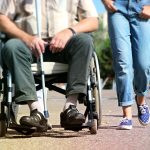
Photo by Klimkin from Pixabay - Surround yourself with positive people. You cannot have a life of positivity while spending a lot of time with people who drag you down. The good news is that there is a simple solution! Surround yourself with people who build you up and make you the best version of you.[28]
- Practice mindfulness/meditation. Perhaps the most widely publicized benefit of meditation is that it makes you happier. A Swedish study found that practicing mindfulness was “strongly related” to a positive state of mind and reduced stress.[29]
Ability to Manage Stress
Identifying what causes you stress will help you manage stress. Managing your time will help you reduce stress; so keeping a calendar and recording when you have appointments or meetings, etc. will help you reduce stress by not panicking when you forget something that you need to do or somewhere you need to be.
Many of the rituals you may do to maintain a positive attitude will also help you reduce stress. Eating healthy foods and getting enough rest will help you have the strength you need to deal with stressful situations. Exercising regularly, doing yoga or meditation will also help you deal with stress better. Seek out social or professional support when needed and do not rely on drugs or alcohol to relieve stress as this may lead to bigger issues.
When dealing with difficult customers you can take a deep breath, count to three in your head, then address the customer in a calm and professional manner. Remember when a customer is angry is usually is not at you personally; their frustrated and upset about some interaction they had with the company. Ignore any personal attacks and exaggerations because a very angry, upset customer may not be acting rationally. Call your manager if the situation escalates and remember not to take it personally. Often upset customers are really nice people underneath it all, and once you fix the issue, they will probably thank you profusely. “Uncovering their expectations will help defuse the emotion, help you keep cool, and keep the conversation focused on problem solving. Keep focusing on what you can do to close the gap between their unmet expectations and their experience of your company’s services and products. When customers are dealt with sincerely and professionally, they are more open to alternative solutions.”[30]
Try to keep a positive attitude and, in your personal life, surround yourself with others who think positively. Accept that there are events that you cannot control. Be assertive instead of aggressive by asserting your feelings, opinions, or beliefs instead of becoming angry, defensive, or passive. Do something every day that brings you joy.
Ability to Manage Time
Managing your time will make you more productive and reduce stress. Use a calendar or schedule book, whether paper or electronic, to keep track of tasks you need to complete. Make a list, assess the value of each task and prioritize tasks, and allow for flexibility.
Watch the “Time Management Techniques for Stress Free Productivity” YouTube video below for some time management tips for stress-free productivity.[31] Transcript for “Time Management Techniques for Stress Free Productivity” Video [PDF–New Tab]. Closed captioning is available on YouTube.
Ability to Work in Teams Effectively
In its Employability Skills 2000+, the Conference Board of Canada lists “the skills you need to enter, stay in, and progress” in the 21st century workplace. The ability to apply teamwork skills is one of the skills listed.[32]
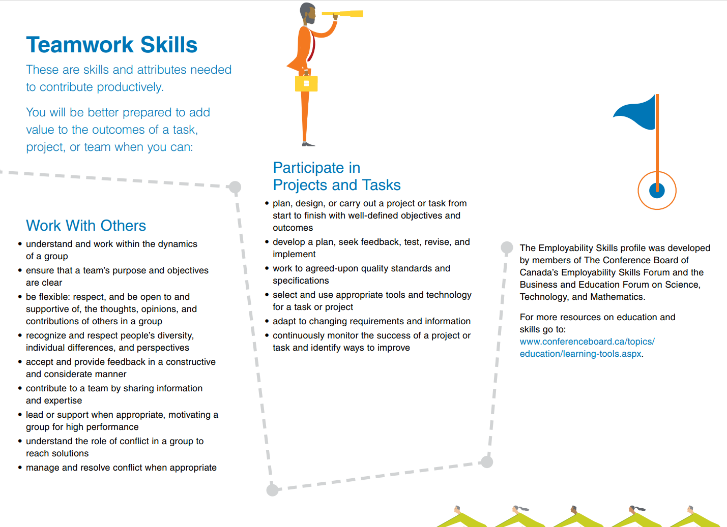
Characteristics of an Effective Team Member
- Shows commitment to the team and its goals
- Works for consensus on decisions
- Shares openly and authentically with others
- Demonstrates reliability to complete tasks
- Involves others in the decision-making process
- Treats others in a respectful and supportive manner
- “Owns” problems rather than blaming them on others
- Listens actively, and attempts to see other’s points of view
- Encourages the development of other team members
- Cooperates and pitches in to help
- Acknowledges and works through conflict constructively
- Considers and uses new ideas and suggestions from others
- Encourages and accepts feedback on their own behavior
- Works toward win-win results
Ability to Contribute to Team Performance
To be a good contributor you must make an effort to support your team members and show interest in working toward team goals. You should learn to compromise and understand things may not always be done as you suggest. You need to be able to negotiate with your team members to settle disputes and make sure everyone is happy with the team’s choices.
Clearly communicating in a timely fashion with team members, and making sure your tone is always professional but friendly, is key to being a positive team contributor.
The bigger the project, the more linked and interdependent are the people and the tasks. Often one task must be done before another one can be completed. This means relying on each other and trusting each other to do what needs to be done in the time given. Your quality of work and ability to meet milestones (intermittent deadlines) are critical to everyone getting their part of the project done on time and with quality results.
Ability to Participate in Team Presentations
To present as a team, you must know each person’s part of the presentation so that should someone need help or become ill the day of the presentation you can step up and present their portion of the overall presentation. You should introduce each member of your team when you begin the presentation and have an introduction. Then as each member presents you use a transition between members; which is simply a sentence to transition from one member’s part to the next.
Each member will accept a task and complete their portion of the presentation, but also help the whole team finalize and make a professional final presentation. When using slides ensure there are no spelling errors and that each slide does not contain too much text. If giving presentations is a part of your job role then it would be wise to review a course or lesson on how to deliver a presentation.
Ability to Participate in Team Meetings
Team meetings are crucial for sharing ideas, disseminating data to everyone at the same time, allowing for discussions, and making decisions. It is important to create an agenda for the meeting and send it out to all members prior to the meeting along with any accompanying documents that may be reviewed during the meeting. This will help keep the meeting discussion on track and moving forward. Often people complain that meetings are a waste of time because nothing gets accomplished. Using an agenda will help the meeting planner get through the tasks intended.
Ability to Participate in Projects and Tasks
Ability is what you’re capable of doing. Motivation determines what you do. Attitude determines how well you do it. It is important to participate in projects and tasks contributing to the team effort even when you are not that interested in your job or the project itself; otherwise, your colleagues and managers may get a negative impression of you which will only hurt your ability to get promotions, bonuses, recognition or work on interesting projects you may wish to be included on. Even if you plan to switch jobs in the near future you may need references from your manager and possibly colleagues so you certainly do not want anyone to see you as non-participative, difficult to get along with, lacking in team spirit, or providing a low quality of work.
Key Takeaways
- Internal customers are the company employees who need support, information or action from another employee. These internal customers may work just down the hall, in another building, or in another country, but they are still part of the company and working to help satisfy external customers.
- External customers are the customers who purchase products or services from the company.
- Customer Service Orientation means that as an employee you are able to display positive attitudes and behaviors, and demonstrate an awareness of the importance of meeting or exceeding customer needs and expectations.
- Service culture in an organization means putting customers at the center of the business model, developing policies, procedures, values, norms, and beliefs that are centered around focusing on customer satisfaction and understanding their needs and wants.
- Verbal communication refers to the ability of a customer service representative to think of the right words in order to appease a customer and provide a solution
- Non-verbal communication refers to gestures, facial expressions, eye contact, body language, posture, and other ways people can communicate without using language.
- Positive language is the art of using words and phrases to communicate a positive, supportive tone to your customers (or anyone else for that matter).
- Active listening means that you focus on what your customer is saying.
- A problem-solving model provides you with concrete, easy to remember steps you can work through when faced with any issue, customer service related or other.
- A positive attitude is a mindset that helps you see and recognize opportunities. It is not always easy to stay positive especially when things do not go as planned, or when dealing with angry customers.
- Service recovery is a company’s resolution of a problem from a dissatisfied customer, converting them into a loyal customer. It is the action a service provider takes in response to service failure.
- To be a valued team member you should make a commitment to the team goals, create a collaborative working environment, and support team decisions.
- Identifying what causes you stress will help you manage stress.
- Managing your time will help you reduce stress; so keeping a calendar and recording when you have appointments or meetings, etc. will help you reduce stress by not panicking when you forget something that you need to do or somewhere you need to be.
End-of-Chapter Exercises
- Cultural Diversity. Understanding cultural diversity in customer service. Search the Internet for differences between cultures and how these differences might affect working relationships between colleagues, interactions with customers, or even interactions with your manager. Searching for power distance, high and low cultural context, individualistic versus communitarian, deductive versus inductive persuasion, time scheduling, and neutral versus emotional cultures will provide you with several starting points.
- Jobs. Search the Internet for “customer service jobs in Toronto” or whatever city you live in. You will probably get many websites in the results. Click on a few and review the job responsibilities, the hourly pay, and the skills you need to perform these jobs. Do any of them interest you? Why or why not? You may find some of these jobs have perks. They offer training and sometimes career paths to a management position. It is a good idea to research the company websites offering these jobs and read more about their mission and values to determine if you would be a good fit.
- Practice Pleasantries. Give yourself a challenge. The next four people you interact with practice saying, please and thank you, and smiling. Do these at the right times, not too much, and not insincerely. Did these small pleasantries enhance your communication? Will you try this more often? Hopefully you will try this when serving customers.
- Angry Customers. Search the Internet for information on “providing customer service to irate customers.” You might try rewording the search criteria using the following topics: conflict resolution, handling difficult customers, and handling angry customers. Share your findings with your class and/or professor.
- Service Breakdowns. Based on your personal experience, why do you think service recovery efforts are often limited in small companies as compared to large organizations? What can be done to better prepare employees of a small company to better handle service breakdowns?
- Negative Phrases. Consider negative phrases. What else could you say to a customer besides, “It’s not my department.” “It’s not my fault.” “She’s away and won’t be back for two weeks and she’s the only one who does that so you will have to wait.” “That’s not our policy.” Discuss these with a partner and see if you can devise some alternative statements that are more positive in tone and bring more value to the customer. Share your examples with the class and/or professor.
- Roleplay Difficult Situation. Roleplay a Difficult Customer Situation. How would you handle this difficult customer situation? Assume you work as a cashier at Loblaws Super Store and as you are scanning a customer’s products for purchase a second customer squeezes up through the line of customers waiting and says, “I am in a hurry and I just have this loaf of bread. Can you just tell me how much it costs and I’ll leave the money right here on the register?” Work with a partner and role-play this scenario, practice how you would handle this situation if you were the employee. Discuss strategies with the class and/or professor.
- Gestures. Gesture Meanings Around the World. Common gestures take on different meanings around the world. As a customer service representative, you may think giving the “thumbs up” to your customer means great, good, OK, but depending on where you are in the world or the culture your customer comes from, you may actually be offending them. Explore the Internet to discover what these gestures mean in different countries. Some countries to compare include: Canada, China, Russia, Mexico, Turkey, India, Greece, and Australia.
 |
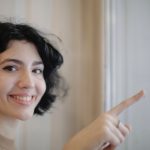 |
 |
 |
 |
Additional Resources
- LinkedIn Learning Customer Service Training
- I was Seduced by Exceptional Customer Service, John Boccuzzi, TedX Bryant U
- 20 Customer Service Training Ideas and Activities for Busy Teams
- Test your communication skill level with a quiz
- 17 Hand Gestures That Can Cause Offense Around the World
- How to Get a Job in Customer Service
- 5 Important Reasons Why Teamwork Matters
- 15 Time Management Tips for Achieving Your Goals
- Stress Management by Mayo Clinic Staff
References
(Note: This reference list was produced using the auto-footnote and media citation features of Pressbooks; therefore, the in-text citations are not displayed in APA style).
Media Attributions
- empskillsfundamental © Conference Board of Canada is licensed under a All Rights Reserved license
- arrow © Kerri Shields is licensed under a CC0 (Creative Commons Zero) license
- Problem solving steps © Kerri Shields is licensed under a CC0 (Creative Commons Zero) license
- employskills © Conference Board of Canada is licensed under a All Rights Reserved license
- wheelchair-1629490_1920 © Photo by Klimkin from Pixabay is licensed under a CC0 (Creative Commons Zero) license
- employskillsteam © Conference Board of Canada is licensed under a All Rights Reserved license
- ok-3061659_640 © Photo by Robin Higgins from Pixabay is licensed under a CC0 (Creative Commons Zero) license
- woman-smiling-3917398 © Photo by Andrea Piacquadio from Pexels is licensed under a CC0 (Creative Commons Zero) license
- boys-271057_640 © Photo by kytrangho from Pixabay is licensed under a CC0 (Creative Commons Zero) license
- man-in-white-dress-shirt-smiling-3598433 © Photo by Charles Wundengba from Pexels is licensed under a CC0 (Creative Commons Zero) license
- youngthumbs-3061652_640 © Photo by Robin Higgins from Pixabay is licensed under a CC0 (Creative Commons Zero) license
- Career Guide. (2020, March 11). Customer service skills: Definitions and 17 examples. Indeed. https://www.indeed.com/career-advice/resumes-cover-letters/customer-service-skills ↵
- Lucas, Robert W. Customer service skills for success. McGraw Hill Education: New York, USA, 2015. ↵
- Mike (2016, February 13). Why it's absolutely OK to send customers to competitors. Digital Spark Marketing. https://digitalsparkmarketing.com/send-customers-to-competitors/ ↵
- Employability Skills 2000+. (2020). Employability skills. The Conference Board of Canada. https://www.conferenceboard.ca/docs/default-source/educ-public/esp2000.pdf?sfvrsn=dd440e69_0 ↵
- Jablonski, N. (2017). What scientific term or concept ought to be more widely known? Edge. https://www.edge.org/response-detail/27212 ↵
- Dev, K. (2017, September 26). 10 tips for effective communication with customers. Customer Think. https://customerthink.com/10-tips-for-effective-communication-with-customers/#:~:text=10%20Tips%20for%20Effective%20Communication%20with%20Customers%201,your%20message%20across.%2010%20Don%E2%80%99t%20take%20short%20cuts ↵
- Ober, K. (2015, December 22). Positive body language. [Video]. YouTube. https://youtu.be/6vT6sqjBFrs ↵
- Gilbert-Jamison, T. (2018, April 26). Service recovery - Do say/Don't say. [Video]. YouTube. https://youtu.be/U2rooZp4SDA ↵
- Bovee, C. & Thill, J. (2017, September 20). Student version: Sharing negative information without being negative. [Video]. YouTube. https://youtu.be/ewIKhqK0ySQ[/ ↵
- Toister, J. (2016, January 30). Customer service fundamentals - Actively listening to customers. [Video]. YouTube. https://youtu.be/rccne8eevxE ↵
- Lucas, R. (n.d.). What is a service breakdown? [Blog]. Customer Service Skills. http://www.customerserviceskillsbook.com/wordpress/what-is-a-service-breakdown/#:~:text=Service%20breakdowns%20occur%20daily%20in%20all%20types%20of,fails%20to%20meet%20customer%20needs%2C%20wants%20and%20expectations ↵
- JMC The Director. (2016, February 10). Dealing with an Angry Customer Training. [Video]. YouTube. https://youtu.be/T20hV4ynU7o ↵
- Solomon, M. (2017, November 19). Thanks a latte: How to fix a customer service failure per Starbucks, Marriott, and Me. https://www.forbes.com/sites/micahsolomon/2017/11/19/thanks-a-latte-how-to-fix-a-customer-service-failure-per-starbucks-marriott-and-me/?sh=4bb0ea84462a ↵
- Indeed Career Guide (2020, January 27). 20 Best practices for email etiquette in the workplace. https://www.indeed.com/career-advice/career-development/email-etiquette#:~:text=20%20Best%20Practices%20for%20Email%20Etiquette%20in%20the,email%20address%20if%20possible.%20...%20More%20items...%20 ↵
- Gilbert-Jamison, T. (2020, July 13). Proper Telephone Etiquette. [Video]. YouTube. https://youtu.be/1KtKNkg4j3s ↵
- Employability Skills 2000+. (2020). Employability skills . The Conference Board of Canada. https://www.conferenceboard.ca/docs/default-source/educ-public/esp2000.pdf?sfvrsn=dd440e69_0 ↵
- Virginia Tech. (n.d.) Professionalism. https://career.vt.edu/develop/professionalism.html ↵
- Mindtools. (n.d.). Professionalism. Meeting the standards that matter. https://www.mindtools.com/pages/article/professionalism.htm ↵
- Bovee, C. & Thill, J. (2020, January 18). The five zones of professional etiquette. [Video]. YouTube. https://youtu.be/A9Q20hZ5ZX4 ↵
- Best Hospitality Degrees. (n.d.) What skills does a customer representative need? Best Hospitality Degrees. https://www.besthospitalitydegrees.com/faq/what-skills-does-a-customer-service-representative-need/ ↵
- Steen, J. (2016, July 15). Breakfast can set you up for a happier, positive day. Huffpost. https://www.huffingtonpost.com.au/2016/07/10/breakfast-can-set-you-up-for-a-happier-positive-day_a_21429436/ ↵
- Australian Fitness Academy. (2018, March 7). How exercise makes you happy. Australian Fitness Academy. https://www.fitnesseducation.edu.au/blog/health/how-exercise-makes-you-happy/ ↵
- Spector, N. (2018, January 9). A smile can trick your brain into happiness—and boost your health. Better. https://www.nbcnews.com/better/health/smiling-can-trick-your-brain-happiness-boost-your-health-ncna822591 ↵
- Deflin, K. (2016, February 16). 10 Positive benefits of listening to music, according to science. Live for Live Music. https://liveforlivemusic.com/features/10-positive-benefits-of-listening-to-music-according-to-science/ ↵
- Harvard Health Publishing. (n.d.). Giving thanks can make you happier. Harvard Medical School. https://www.health.harvard.edu/healthbeat/giving-thanks-can-make-you-happier ↵
- Steen, J. (2016, July 15). Breakfast can set you up for a happier, positive day. Huffpost. https://www.huffingtonpost.com.au/2016/07/10/breakfast-can-set-you-up-for-a-happier-positive-day_a_21429436/ ↵
- Srennivasan, S, Ph.D., and Weinberger, L., Ph.D. (2017, November 16). Why random acts of kindness matter to your well-being. Psychology Today. https://www.psychologytoday.com/ca/blog/emotional-nourishment/201711/why-random-acts-kindness-matter-your-well-being ↵
- Stoneking, T. (n.d.). 8 Amazing things will happen when you surround yourself with positivity. Lifehack. https://www.lifehack.org/338213/8-amazing-things-will-happen-when-you-surround-yourself-with-positivity ↵
- Webb, A. (2017, January 12). Can meditation make you happier and more productive? Policygenius. https://www.policygenius.com/blog/can-meditation-make-happier-productive/ ↵
- Earl, D. (n.d.). Stress management tips for customer service professionals. Donna Earl Training. https://www.donnaearltraining.com/articles-quizzes/stress-management-tips-for-customer-service-professionals/ ↵
- Young Entrepreneurs Forum. (2016, August 15). Time management techniques for stress free productivity. [Video]. YouTube. https://youtu.be/IGVQPU-L7cQ ↵
- Employability Skills 2000+. (2020). Employability skills . The Conference Board of Canada. https://www.conferenceboard.ca/docs/default-source/educ-public/esp2000.pdf?sfvrsn=dd440e69_0 ↵
are the company employees who need support, information or action from other employees. These internal customers may work just down the hall, in another building, or in another country, but they are still part of the company and working to help satisfy external customers.
are the customers who purchase products or services from the company. Employees who work in job positions that require them to interface with external customers directly might be referred to as front-line/front-facing/front-end/customer-facing employees. Those that work to serve internal customers are working in back-end/back-office/behind-the-scene job positions.
means that as an employee you are able to display positive attitudes and behaviors, and demonstrate an awareness of the importance of meeting or exceeding customer needs and expectations.
in an organization means putting customers at the center of the business model, developing policies, procedures, values, norms, and beliefs that are centered around focusing on customer satisfaction and understanding their needs and wants.
refers to the ability of a customer service representative to think of the right words in order to appease a customer and provide a solution
refers to gestures, facial expressions, eye contact, body language, posture, and other ways people can communicate without using language.
is the art of using words and phrases to communicate a positive, supportive tone to your customers (or anyone else for that matter).
is the art of using words and phrases to communicate a positive, supportive tone to your customers (or anyone else for that matter).
occur daily in all types of organizations. They happen whenever the product or service delivered fails to meet customer needs, wants and expectations.
is a company's resolution of a problem from a dissatisfied customer, converting them into a loyal customer. It is the action a service provider takes in response to service failure.
provides you with concrete, easy to remember steps you can work through when faced with any issue, customer service related or other.
is a mindset that helps you see and recognize opportunities. It is not always easy to stay positive especially when things do not go as planned, or when dealing with angry customers.

